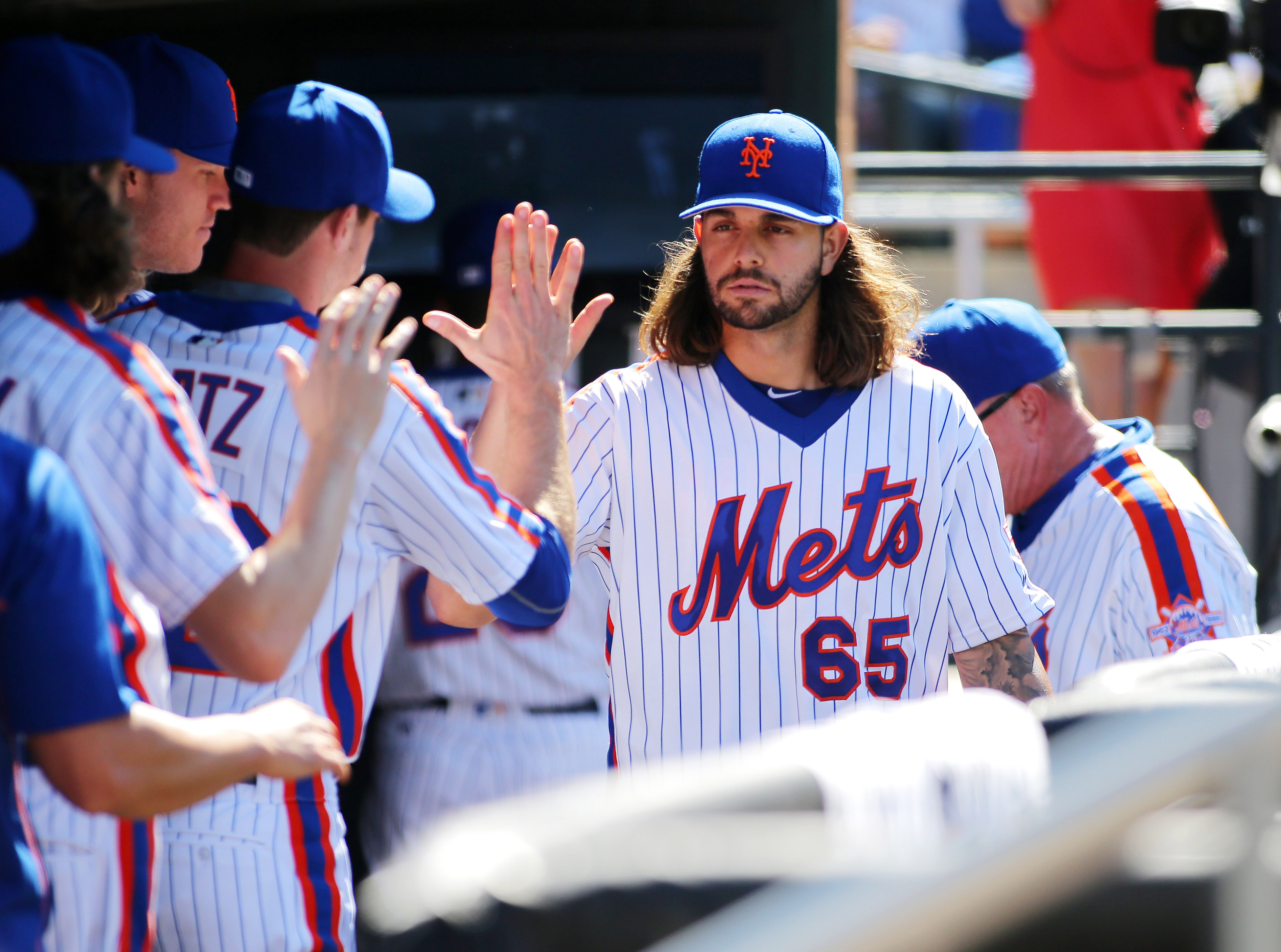Robert Gsellman came into the season as roughly the 11th guy in line for starts for the 2016 Mets. The Opening Day rotation—Harvey, deGrom, Syndergaard, Matz, Colon—looked pretty locked in. Zack Wheeler was supposed to come back before the All-Star break. Logan Verrett and Sean Gilmartin had already proven their mettle in the majors in long relief/spot start duty. Rafael Montero was coming back off an injury-riddled 2015, but he rated to be in line for a call-up. And Gabriel Ynoa, a similarly-ranked prospect to Gsellman, started the season already at Triple-A, a level closer to the majors.
After that, the injury deluge. Harvey’s out for the season. deGrom and Matz are both struggling through injuries. Syndergaard has needed to be skipped a few times. Wheeler never came back. Verrett and Gilmartin have been both bad and hurt. And thus the Mets have needed to reach deep into the system, not just for Montero and Ynoa, but also for Gsellman. Except the Mets threw one more obstacle in Gsellman’s path to starting: bringing back Jon Niese.
I don’t know what prompted the Mets to start Niese over Gsellman on August 23. Niese was having a bad-to-awful 2016 by most major pitching metrics. His ERA (5.50) and FIP (5.65) were dreadful, and his DRA (4.63) was mediocre. The Mets reacquired Niese from the Pirates at the deadline with the express intent of using him out of the bullpen. His first start on August 17 was uninspired at best—four runs over 4.7 innings. And Niese went into the August 23 start with knee troubles. Yet the Mets thought he was so superior an option to Gsellman that they started Niese over him despite all this.
Niese, of course, lasted a mere four batters, and Gsellman came in behind him with 3.7 innings of scoreless relief, finally earning something resembling a regular rotation slot. Gsellman has followed that up with two solid starts, and although the peripherals aren’t quite what you’d hope (11/7 K/BB ratio, 5.53 DRA), we’re still dealing with tiny samples. More importantly, it all looks right.
How is Gsellman in the majors different from the prospect we saw in the minors? Before the season, Jeffrey Paternostro, in ranking him as the ninth best prospect in the Mets system, had Gsellman sitting 88-92 (lower part of the band being his two-seamer) and touching 94 with the fastball, though noting reports from the past that he’d hit a little higher, and using his curve as his primary out pitch with no significant slider present. At the time, Gsellman profiled for Jeffrey as a fifth starter or pen arm. Jeffrey saw Gsellman again in May for Double-A Binghamton, and while his addition of a slider bumped him up to a potential fourth starter, the pitch wasn’t all the way there yet, and the overall profile was largely the same.
Gsellman’s Brooks Baseball player card through his first three major league appearances looks little like the reports Jeffrey had. It’s not like those were the wrong reports, either, he’s just clearly not the same pitcher he was even earlier this season. His average four-seam fastball has been at 94.7—higher than any scouting report in the BP database even has Gsellman touching. His two-seamer, sitting in the high-80s just a few months ago, is coming in at a 94.3 average. Both fastballs have touched 97. His slider, now fully a Warthen Slider, is bordering on a cutter as the Warthen Slider tends to do; no matter what you call it, it’s now coming in at 87-90 and touching 91. That’s where his fastballs were not all that long ago. Both the slider/cutter and the curveball have been effective at generating swings-and-misses. Combined with a fringe-average change that’s stayed relatively static, and Gsellman suddenly has quite a lot of weapons to attack hitters with.
So here’s what you really care about: what is Robert Gsellman’s future now? At the points Jeffrey described him as a four or a five, I certainly would have agreed with those assessments. But we now have the most recent data and it conflicts a lot with the old reports. He’s throwing a lot harder with seeming ease and consistency, and given that he was always a projectable guy and there were occasional reports of big radar gun readings, he may not give that back. He’s throwing a new slider that might already be his best pitch, and that’s probably a real gain given how many Mets have picked up plus hard sliders that all pretty much look the same. For the rest of 2016, he should be fresh and without any sort of innings limit problem thanks to a fortuitously timed missed month with a groin injury.
The easy comparison here, the one Mets fans are already making, is Jacob deGrom. It’s a visual comp as much as anything—similar build, similar hair, even similar faces. And it’s a bad comp, because prospects at the level of Jacob deGrom and Robert Gsellman simply don’t become true aces like deGrom has very often. Diving a little further as to why Gsellman probably isn’t getting there, despite some similarities in velocity and repertoire, Gsellman simply doesn’t possess deGrom’s elite fastball command or deGrom’s plus-or-higher change. Those are really the things that make deGrom an ace.
But Gsellman absolutely has made some of the jump that deGrom made, and that might be enough to make him a fine starting pitcher in the majors. A reasonable projection for him, assuming health and normal continuing refinement, is at least a mid-rotation arm now, and he could optimistically be a good number two starter if all breaks right. That’s quite a rise in quite a short time. It’s still early, but this sure looks like yet another win for Dan Warthen and the pitching side of the player development staff.
Photo Credit: Andy Marlin-USA TODAY SPORTS

3 comments on “Gsellman is Ggood!”
Comments are closed.